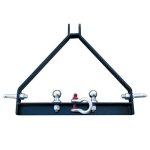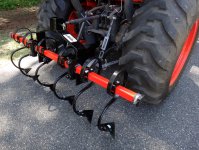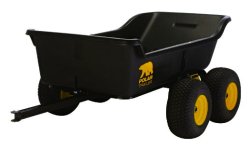jeff9366
Super Star Member
- Joined
- Jan 14, 2011
- Messages
- 12,391
- Tractor
- Kubota Tractor Loader L3560 HST+ ~~~~~~~~~~~~~ 3,700 pounds bare tractor, 5,400 pounds operating weight, 37 horsepower
TennesseeBill
I have a couple of new questions:
1. I have read about tire ballast and the different types from water to beet juice. One dealer offers tire ballast standard. Is "loading" tires a good idea? What harm outside of rust can it do and would that be offset by the advantages?
Only rear tires are ballasted. Front axle is too light and pivots, so fronts are not ballasted. Power steering is not designed for loaded front tires.
Rear tires are almost always ballasted 3/4 full for tractor work on slopes. This lowers tractor center-of-gravity on slopes. Liquid covers internal hub so hub is continually submerged. Tractors have no suspension other than air in the tires. If tires are filled 100% ride is terrible and traction degraded because rear tire flex is degraded.
If you buy a high powered tractor, say 4,000 pounds bare tractor with 60-horsepower engine, loading tires will improve traction. Alternative is bolt-on cast iron wheel weights for traction on level ground. Sometimes both liquid and wheel weights are installed. Liquid and cast iron have advantages/disadvantages to each. But for slopes, to improve stability, 3/4 liquid is better than cast iron.
If you run tractor over hard surface roads at high speeds, 14 to 18 miles per hour, loaded rear tires (1,400 pounds) can negatively influence handling and braking. If you get a puncture, you lose the liquid. Changing liquid filled rear tires is at least a two person, sweaty, potentially hazardous job @ 700 pounds per rear wheel.
All three of my tractors have had rear tires filled only with air. I minimally compact soil; a tenant of sustainable agriculture. When I need ballast weight I mount a Cultipacker or Box Blade on the Three Point Hitch for counterbalance. My Three Point Hitch weight can be removed. Weight cantilevered on the Three Point Hitch is more effective counterbalance weight than rear tire weight on the rear axle.
A heavy tractor with air filled R4/industrial rear tires may still traverse lawns in 2-WD without marking; loading the rear tires usually marks/ruts lawns. ( I never mark/rut lawns with my 5,400 pound Kubota L3560 with air filled R4/industrial rear tires in 2-WD.)
Rear tire chains, rubber or steel, are a neglected option for improving tire traction in fields. I have no experience with chains as my tractor has a modest 37-horsepower engine. However, T-B-N correspondents who use tire chains are fans.
2. I keep reading about remotes. I believe they are additional high pressure hydraulic lines for other implements!? Should get remotes with the tractor and if so how many? I guess they would power something like a backhoe?
Backhoes and most other powered implements obtain power mechanically from the PTO. PTO powers a pump integral to Backhoe, one reason Backhoes are $8,000. (Hydraulic pumps integral to CUT tractors have very low flow rates.) Nothing you have written thus far establishes a need for a Backhoe, which must be removed to access the Three Point Hitch.
Rear remotes primarily for adding hydraulic Three Point Hitch Top Link and right Lifting Rod adjustment from the tractor operating station. (two remotes) This allows changes in implement rake (Top Link) and implement tilt (right Lifting Rod). These two adjustments require minimal hydraulic flow. Alternative is to get off the tractor and turn.screw in the adjustments manually at the Three Point Hitch via Top Link and right Lifting Rod.
Big Ag tractors pulling complicated implements like combines often have 6-8 rear remotes. Big Ag tractors have high capacity auxiliary hydraulic pumps for implements.
If you install a FEL grapple you need a front remote to hydraulically open and close the grapple jaws.
Price remotes. Buy if you think they are a value in your situation. You have quite a bit of land. I do not think rear remotes are too much more expensive installed later, but consult your dealer.
3. What about rear SCVs?
Do not abbreviate. What is an SCV?
4. How much consideration should be given to the weight of the tractor? I keep reading the weight really determines the max of certain things you can do. So I guess if deciding between different tractors and everything being somewhat equal should weight be a large part of the decision if there is a significant difference? I hope that is clear.
Tractor weight should be the first decision you reach. Weight means thicker steel, less subject to bending when tractor is doing heavy work or you inadvertently bash a tree. Weight equals traction. You need a tractor of at least 4,000 pounds bare weight; 6,000 pounds bare tractor weight not too much.
Horsepower second, when determining width of PTO powered implements you will use. Rotary Cutters and Roto-tillers are PTO powered implements.
5. I normally do not get extended warranties on items I buy, including vehicles as I tend to find they are never used unless you misuse something and then the warranty might not be enforceable. What about tractors though?
Tractor warranties are not inclusive like car warranties. Most of what owners feel should be warranty repairs are categorized as operator error and not covered under tractor warranties.
Kubota sponsored and highly regarded $400/year KTAC (Kubota Tractor Acceptance Corporation) insurance covers most repairs; less $250 deductible. I have used my KTAC insurance twice, much more than offsetting $400/year cost.
6. Is a cab is worth the extra money?
In fields yes, for some. In woods, fragile. $8,000 with heat and A/C. It is your money.
(As a newbie is is probable you would damage a cab repeatedly during first 400 engine hours, learning to operate your tractor.)
New tractor cost $37,000 to $55,000, plus implements and attachments. (Cab + Backhoe = $16,000.)
I have a couple of new questions:
1. I have read about tire ballast and the different types from water to beet juice. One dealer offers tire ballast standard. Is "loading" tires a good idea? What harm outside of rust can it do and would that be offset by the advantages?
Only rear tires are ballasted. Front axle is too light and pivots, so fronts are not ballasted. Power steering is not designed for loaded front tires.
Rear tires are almost always ballasted 3/4 full for tractor work on slopes. This lowers tractor center-of-gravity on slopes. Liquid covers internal hub so hub is continually submerged. Tractors have no suspension other than air in the tires. If tires are filled 100% ride is terrible and traction degraded because rear tire flex is degraded.
If you buy a high powered tractor, say 4,000 pounds bare tractor with 60-horsepower engine, loading tires will improve traction. Alternative is bolt-on cast iron wheel weights for traction on level ground. Sometimes both liquid and wheel weights are installed. Liquid and cast iron have advantages/disadvantages to each. But for slopes, to improve stability, 3/4 liquid is better than cast iron.
If you run tractor over hard surface roads at high speeds, 14 to 18 miles per hour, loaded rear tires (1,400 pounds) can negatively influence handling and braking. If you get a puncture, you lose the liquid. Changing liquid filled rear tires is at least a two person, sweaty, potentially hazardous job @ 700 pounds per rear wheel.
All three of my tractors have had rear tires filled only with air. I minimally compact soil; a tenant of sustainable agriculture. When I need ballast weight I mount a Cultipacker or Box Blade on the Three Point Hitch for counterbalance. My Three Point Hitch weight can be removed. Weight cantilevered on the Three Point Hitch is more effective counterbalance weight than rear tire weight on the rear axle.
A heavy tractor with air filled R4/industrial rear tires may still traverse lawns in 2-WD without marking; loading the rear tires usually marks/ruts lawns. ( I never mark/rut lawns with my 5,400 pound Kubota L3560 with air filled R4/industrial rear tires in 2-WD.)
Rear tire chains, rubber or steel, are a neglected option for improving tire traction in fields. I have no experience with chains as my tractor has a modest 37-horsepower engine. However, T-B-N correspondents who use tire chains are fans.
2. I keep reading about remotes. I believe they are additional high pressure hydraulic lines for other implements!? Should get remotes with the tractor and if so how many? I guess they would power something like a backhoe?
Backhoes and most other powered implements obtain power mechanically from the PTO. PTO powers a pump integral to Backhoe, one reason Backhoes are $8,000. (Hydraulic pumps integral to CUT tractors have very low flow rates.) Nothing you have written thus far establishes a need for a Backhoe, which must be removed to access the Three Point Hitch.
Rear remotes primarily for adding hydraulic Three Point Hitch Top Link and right Lifting Rod adjustment from the tractor operating station. (two remotes) This allows changes in implement rake (Top Link) and implement tilt (right Lifting Rod). These two adjustments require minimal hydraulic flow. Alternative is to get off the tractor and turn.screw in the adjustments manually at the Three Point Hitch via Top Link and right Lifting Rod.
Big Ag tractors pulling complicated implements like combines often have 6-8 rear remotes. Big Ag tractors have high capacity auxiliary hydraulic pumps for implements.
If you install a FEL grapple you need a front remote to hydraulically open and close the grapple jaws.
Price remotes. Buy if you think they are a value in your situation. You have quite a bit of land. I do not think rear remotes are too much more expensive installed later, but consult your dealer.
3. What about rear SCVs?
Do not abbreviate. What is an SCV?
4. How much consideration should be given to the weight of the tractor? I keep reading the weight really determines the max of certain things you can do. So I guess if deciding between different tractors and everything being somewhat equal should weight be a large part of the decision if there is a significant difference? I hope that is clear.
Tractor weight should be the first decision you reach. Weight means thicker steel, less subject to bending when tractor is doing heavy work or you inadvertently bash a tree. Weight equals traction. You need a tractor of at least 4,000 pounds bare weight; 6,000 pounds bare tractor weight not too much.
Horsepower second, when determining width of PTO powered implements you will use. Rotary Cutters and Roto-tillers are PTO powered implements.
5. I normally do not get extended warranties on items I buy, including vehicles as I tend to find they are never used unless you misuse something and then the warranty might not be enforceable. What about tractors though?
Tractor warranties are not inclusive like car warranties. Most of what owners feel should be warranty repairs are categorized as operator error and not covered under tractor warranties.
Kubota sponsored and highly regarded $400/year KTAC (Kubota Tractor Acceptance Corporation) insurance covers most repairs; less $250 deductible. I have used my KTAC insurance twice, much more than offsetting $400/year cost.
6. Is a cab is worth the extra money?
In fields yes, for some. In woods, fragile. $8,000 with heat and A/C. It is your money.
(As a newbie is is probable you would damage a cab repeatedly during first 400 engine hours, learning to operate your tractor.)
New tractor cost $37,000 to $55,000, plus implements and attachments. (Cab + Backhoe = $16,000.)
Last edited:


